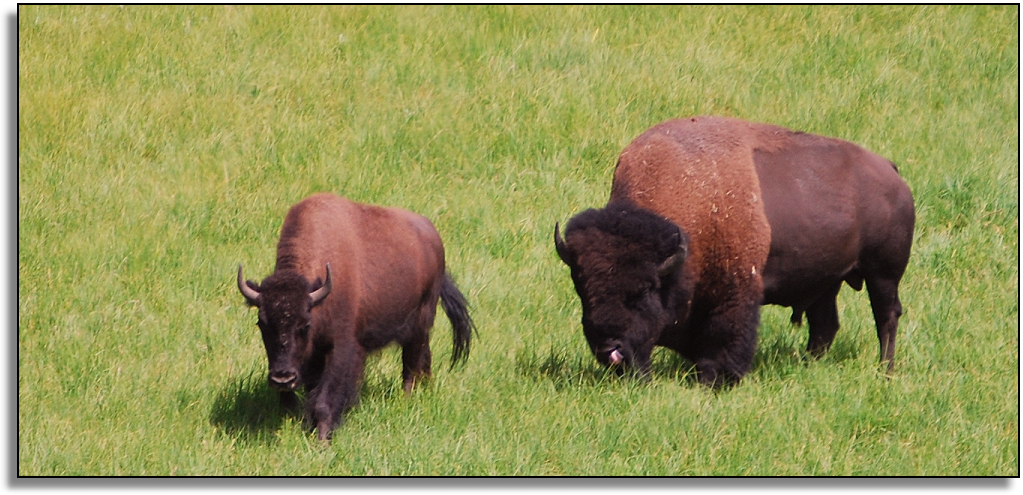|

|
          |

What
is a Wild Bison? The Legal Definition
For Montana bison, there are two definitions of wildness: a legal
definition and a biological definition. Only the former is considered
here. The biological definition is discussed in a separate communication.
In the Montana Code, Chapter
81, “wild bison” means a bison that has not been
reduced to captivity and is not owned by a person. In Chapter
87, “wild buffalo” are a “game animal”;
and wild buffalo are bison that have not been reduced to captivity.
Clearly, wild bison are a publicly-owned game species, therefore
a public trust resource.
But the issue of captivity is more ambiguous. The form and degree
of captivity has not been defined in Montana law. Elsewhere in
the Code
at 87-1-216, the prescription for wild bison management refers
to “containment”. But again, “contained”
is not well defined and provides little help in defining “captivity”.
Clearly, bison confined to a small pasture are captive and contained
and therefore not wild. Moreover, ethical issues associated with
hunting animals in a pen suggest that such bison are not “game”.
But how large must a containment area be for bison to be declared
free-ranging and at least somewhat difficult to hunt – and
therefore “wild game”?
The form of containment is also an issue. Fences are not the only
option. Natural barriers that bison are unlikely to cross may
contribute to containment. On the CMR National Wildlife Refuge,
Fort Peck Reservoir is a potential barrier, at least when unfrozen.
Probability that bison would attempt crossing an icy Fort Peck
Reservoir remains unknown. Steep terrain and dense forests might
also serve as barriers, to a degree that can only be tested with
bison on the ground. (Similarly, livestock are often contained
by drift fences that end in habitat where cattle are unlikely
to go to circumnavigate the fence.)
What if bison are constrained in a large area by a combination
of fences and natural barriers, but make very infrequent excursions,
only to always be hazed back to the center of their designated
range? Are they still legally contained? or captive? Are they
legally wild?
Captivity may also be manifested by frequent handling of the animals,
perhaps with selective culling, vaccinations, and other imposing
activities. Selective culling might be used to alter and control
the sex-age composition of a bison herd and to eliminate natural
fluctuations in abundance. Winter feeding and artificial watering
could also contribute to “captivity”.
Under existing law, a generous but still imprecise interpretation
of the captivity standard for wild bison might be that wild bison
must range freely, year-round, over a very large area and must
endure very little or no artificially intrusive management.
Legal Categories
of Bison in Montana
Legally, Montana law recognizes 5 categories of bison in the state.
-
Several thousand private
livestock, governed largely under the Montana Code, Chapter
81 by the Department of Livestock. Almost all these animals
are being domesticated with each generation. The significant
exception are bison on the American Prairie Reserve in northcentral
Montana, where bison roam over a large and growing available
landscape, and handling of the animals is minimized. (But APR’s
bison are still, legally, livestock managed under Chapter 81.
-
About 350 bison on the National
Bison Range are “display animals” in an exhibition
pen, as defined in 87-1-711
and 712.
They are managed by the U. S. Fish & Wildlife Service.
-
Wild public bison seasonally
visit Montana from Yellowstone National Park. They are recognized
uniquely in Montana law under 81-2-120,
requiring that they be intensively controlled as diseased animals.
Each year, several hundred are harvested by Native American
and public hunters or captured and sent to slaughter. Public
hunts are managed by Montana Fish, Wildlife & Parks under
Department of Livestock oversight.
-
Bison on reservations in
both commercial and cultural herds belong to Montana Native
American tribes, where management is controlled by each tribe.
-
Wild public bison not exposed
to or infected with a dangerous or contagious disease are recognized
in Chapter 87 of the Montana Code. Currently, there are no such
bison in Montana. However this legal designation allows for
restoring wild bison and offers the opportunity for melding
the legal and biological definitions of wildness.
|
Site designed and maintained
by Kathryn QannaYahu Kern |

